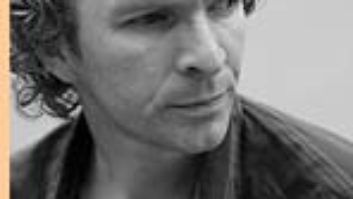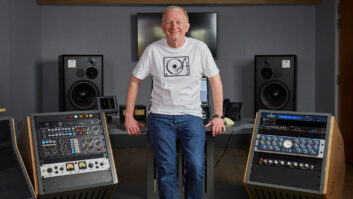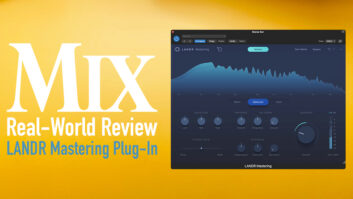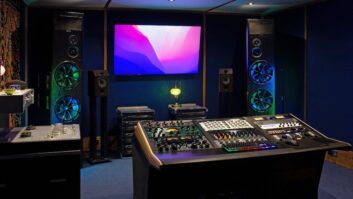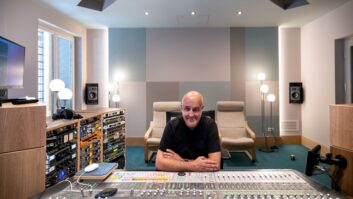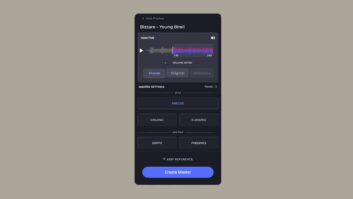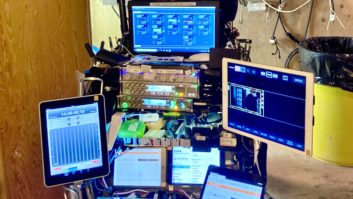
On Friday, January 25, at 7 p.m. EST, Gene Holder and Roger Johansen (pictured, L-R) will host a party celebrating the opening of their new mastering facility in Weehawken, N.J., in convenient proximity to Midtown Manhattan via the Lincoln Tunnel. What’s more, Tangerine Mastering is located within a dedicated production arts building owned by entrepreneur John Hanti that houses other music- and entertainment-related businesses.
Johansen relates that Tangerine Mastering was designed to be as acoustically precise as possible by John Storyk of Walters-Storyk Design Group (WSDG; www.wsdg.com), and that it was acoustically treated by Sam Berkow of SIA Acoustics (www.siaacoustics.com) in New York City. In addition, Johansen and Holder (former bassist in The dB’s) hired engineer Andreas K. Meyer, who previously worked at Sony Mastering in New York City, to be their lead mastering engineer; Meyer has extensive experience with classical music, and his credits include cellist Yo-Yo Ma, violinists Hilary Hahn and Joshua Bell, conductor/composer Esa-Pekka Salonen, the Los Angeles Philharmonic, the New York Philharmonic and the Harlem Boys Choir. Meyer shared a Grammy Award in 2000 in the Best Historical Album category for Louis Armstrong—The Complete Hot Five & Hot Seven Recordings.

I spoke with Johansen about Tangerine Mastering on the eve of its opening-night party.
How did you decide to launch a mastering business?
This is actually my third studio. I had a small studio in the suburbs of New Jersey from 1985 to 1990, and then in probably about 1990-91, Gene and I opened a large room in Hoboken called Jolly Roger. It was a great time to run a studio. We had 5,500 square feet and we had a room [that] could accommodate a 40-piece orchestra. We had a 48-input Neve console and analog tape machines, and had a great time for 12 years. And finally, the landlord built condos there. In that time period we were doing Pro Tools post-production for video. We did all the post-production for Daria, the MTV cartoon, and we did Hedwig and the Angry Inch—we did some work with the music for that. We started doing some mastering at that point. We had an old, classic SADiE system, and we realized at the end of our lease that people were coming to use our big rooms to record drums in our 30-by-40-foot cavernous room, but then they’d go back home and work. [But] they’d always want us to master their final projects because we knew what we were listening for. So, we decided to build a mastering room. We contacted John Storyk, and said we wanted to do this project right. We built it very meticulously, floating the floors and doing what John planned for us.
Why did you name your facility “Tangerine”?

Part of it is a musical reference, but for me, at least, part of it’s an aesthetic reference. I guess the obvious [reason] is the song “Tangerine” by Led Zeppelin. But my partner Gene and I, we both collect vintage furniture, vintage-modern, and tangerine is just sort of a color that really stands out.
Could you talk about the building you’re in? It sounds like there’s an artists’ community there.
John Hanti, who owns the building, originally owned an equipment rental company called SST. He would do the P.A. for Ozzfest and the lighting, and he would work with Beyoncé and everybody. He has a large soundstage where he sets up the touring equipment, and people rehearse there. He actually has a master plan for this building. He’s gathered a lot of people that he knows from the studio community, and people have been moving their studios into his building. He has a place called HarariVille, which is a really nice Neve room. He has a place called The Machine, which is a pretty edgy-type recording studio—a lot of metal bands and things like that. He has a record company in the building, which is Bar/None Records, and he has a large college radio promotion company called The Syndicate. John knew us for a long time, and he wanted us to open a mastering room in his building, so when we were building it, he brought a lot of his friends in to consult on the project. We’re happy to be in his building. It’s all studios and all music, and [there’s] even an entertainment lawyer in the building. It’s a one-stop.
Our room has 18- to 19-foot ceilings. We built a room within a room, which is the way you should really do it. We floated everything; none of the walls [are] touching the building. We had everything from electrical conduit to the fire extinguishers on flexible arms, so that they don’t carry any vibration.

What are your most essential pieces of gear?
This room is sort of like an amalgam of the best [analog] equipment we could find along with really great digital equipment. We have just about every digital mastering workstation there is. We have a brand-new SADiE [PCM8M DAW] system and we’re a beta tester on Pyramix [Version] 6. In our production room, we have [Steinberg] WaveLab; we like that for production editing. And of course we have a Pro Tools HD2 system, and I’m testing out BIAS Peak 6 XT with their DDP export option. We’re over-built on workstations, but it’s good because certain people have certain preferences, and I think we have to cover every engineer that works with us.

Tangerine Mastering’s rack of vintage Pultec modules
The centerpiece of our studio is an original EMI mastering chain [for outboard processing, comprising the TG12412, TG12413 and TG12414]. We were able to buy one, so we have one of the 14 original Abbey Road mastering chains. We love the way it sounds [laughs]. We have some Neve compressors. SPL’s newest EQ is called the PQ, the mastering EQ, which has total recall; it’s all motorized faders. For passive EQ, we have a Cinema [Engineering] EQ, which is sort of rare. We have a whole rack of vintage Pultecs, which I’ve had forever.
Your location seems strategic, in that you’re relatively close to Manhattan, across the Hudson River.
We’re closer to Midtown Manhattan than most places in Manhattan. Somebody came into the studio from Midtown yesterday, and it took him less than 10 minutes to get across and into the building. Usually you can’t get that fast of a trip within Manhattan. So, we’re pretty accessible.
I guess being surrounded by all those entertainment-related businesses also helps.
We’re hoping to do some of our work also [via] Internet downloads, too. We’re having an FTP download on our Website so people can download their files, and then we can just transfer them back to them.
For the approval process?
Well, actually the idea really is to send it right to the pressing plant by direct file transfer. [With] DDP master imaging, you can send that directly to the plant and they can secure it and never have to have a physical product transfer. But things are [still] old school. [Even though] people send in stuff over the Internet, I still like to send them the CD [laughs]. For some reason, it makes me feel like they’re getting something in their hands, and they know it’s real. So, we can do it either way, but I’m still a little old-school on that. I like having files sent to me electronically, but I still like sending them to people physically. And those larger record companies have a lot of protocols for security, so they really do want it transferred electronically over a secured network. But [for] indie bands and individual artists that we deal with, people like to have something in their hands to listen to and play on their CD player.
What is your association with Andreas Meyer, who’s going to be the lead mastering engineer?
He was working at Sony up until the summer. I think the mastering business has sort of been turned upside down by the closing of Sony in Manhattan. We just feel fortunate to have him working with us. He has a good reputation. He gives a lot of dimension to the studio because he has a really great classical background. He owns a classical record label. He has a side project where he records new classical artists on location and puts those recordings out on his own label. And he can rock ’n’ roll, too—he’s pretty versatile.
Is there anything that you’d like to say about the opening party?
We’re trying to have more of an industry party, so we’ve invited most of the clients that we worked with in our old studio. We’re hoping that a lot of old friends show up, and a lot of new friends, too. We’re good at parties! If anybody wants to come, they can call or e-mail, and we’ll give them directions. We’re going to have some good food, and we’ll have a DJ, and really introduce people to the building and the studio. Maybe some celebrities will be there; we’ll see.
For more information on Tangerine Mastering, visit www.tangerinemastering.com and www.myspace.com/tangerinemastering.
